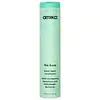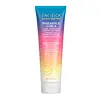What's inside
What's inside
 Key Ingredients
Key Ingredients

 Benefits
Benefits

 Concerns
Concerns

 Ingredients Side-by-side
Ingredients Side-by-side

Water
Skin ConditioningMyristyl Alcohol
EmollientPropylene Glycol
HumectantCetearyl Alcohol
EmollientCetrimonium Chloride
AntimicrobialHippophae Rhamnoides Fruit/Seed Oil
AntimicrobialBorago Officinalis Seed Oil
EmollientMangifera Indica Seed Butter
Skin ConditioningButyrospermum Parkii Butter
Skin ConditioningHydroxypropyl Guar Hydroxypropyltrimonium Chloride
Aloe Barbadensis Leaf Juice
Skin ConditioningGlycerin
HumectantHydrolyzed Quinoa
Skin ConditioningAminomethyl Propanol
BufferingBis-PCA Dimethicone
Butylene Glycol
HumectantC11-15 Pareth-7
EmulsifyingC12-16 Pareth-9
EmulsifyingCaprylyl Glycol
EmollientDecyl Oleate
EmollientDisodium PEG-12 Dimethicone Sulfosuccinate
CleansingTrideceth-12
EmulsifyingTrimethylsiloxyamodimethicone
Citric Acid
BufferingEtidronic Acid
Lauryl Alcohol
EmollientHydrogenated Palm Glycerides Citrate
EmollientPhenoxyethanol
PreservativePotassium Sorbate
PreservativeSodium Benzoate
MaskingCetyl Alcohol
EmollientBenzyl Alcohol
PerfumingTocopherol
AntioxidantParfum
MaskingBenzyl Benzoate
AntimicrobialHydroxycitronellal
PerfumingLimonene
PerfumingWater, Myristyl Alcohol, Propylene Glycol, Cetearyl Alcohol, Cetrimonium Chloride, Hippophae Rhamnoides Fruit/Seed Oil, Borago Officinalis Seed Oil, Mangifera Indica Seed Butter, Butyrospermum Parkii Butter, Hydroxypropyl Guar Hydroxypropyltrimonium Chloride, Aloe Barbadensis Leaf Juice, Glycerin, Hydrolyzed Quinoa, Aminomethyl Propanol, Bis-PCA Dimethicone, Butylene Glycol, C11-15 Pareth-7, C12-16 Pareth-9, Caprylyl Glycol, Decyl Oleate, Disodium PEG-12 Dimethicone Sulfosuccinate, Trideceth-12, Trimethylsiloxyamodimethicone, Citric Acid, Etidronic Acid, Lauryl Alcohol, Hydrogenated Palm Glycerides Citrate, Phenoxyethanol, Potassium Sorbate, Sodium Benzoate, Cetyl Alcohol, Benzyl Alcohol, Tocopherol, Parfum, Benzyl Benzoate, Hydroxycitronellal, Limonene
Water
Skin ConditioningCetrimonium Chloride
AntimicrobialCetyl Alcohol
EmollientSorbitol
HumectantCaprylic/Capric Triglyceride
MaskingAnanas Sativus Fruit Extract
Skin ConditioningHelianthus Annuus Seed Oil
EmollientBehentrimonium Methosulfate
Cetearyl Alcohol
EmollientPanthenol
Skin ConditioningTocopherol
AntioxidantChamomilla Recutita Flower
Skin ConditioningRubus Idaeus Fruit Extract
AstringentStearamidopropyl Dimethylamine
EmulsifyingEmulsifying Wax Nf
Simmondsia Chinensis Seed Oil
EmollientLecithin
EmollientHyaluronic Acid
HumectantHydrolyzed Soy Protein
HumectantPotassium Sorbate
PreservativeSodium Benzoate
MaskingEthylhexylglycerin
Skin ConditioningParfum
MaskingWater, Cetrimonium Chloride, Cetyl Alcohol, Sorbitol, Caprylic/Capric Triglyceride, Ananas Sativus Fruit Extract, Helianthus Annuus Seed Oil, Behentrimonium Methosulfate, Cetearyl Alcohol, Panthenol, Tocopherol, Chamomilla Recutita Flower, Rubus Idaeus Fruit Extract, Stearamidopropyl Dimethylamine, Emulsifying Wax Nf, Simmondsia Chinensis Seed Oil, Lecithin, Hyaluronic Acid, Hydrolyzed Soy Protein, Potassium Sorbate, Sodium Benzoate, Ethylhexylglycerin, Parfum
 Reviews
Reviews

Ingredients Explained
These ingredients are found in both products.
Ingredients higher up in an ingredient list are typically present in a larger amount.
Cetearyl alcohol is a mixture of two fatty alcohols: cetyl alcohol and stearyl alcohol. It is mainly used as an emulsifier. Emulsifiers help prevent the separation of oils and products. Due to its composition, it can also be used to thicken a product or help create foam.
Cetearyl alcohol is an emollient. Emollients help soothe and hydrate the skin by trapping moisture.
Studies show Cetearyl alcohol is non-toxic and non-irritating. The FDA allows products labeled "alcohol-free" to have fatty alcohols.
This ingredient is usually derived from plant oils such as palm, vegetable, or coconut oils. There is debate on whether this ingredient will cause acne.
Due to the fatty acid base, this ingredient may not be Malassezia folliculitis safe.
Learn more about Cetearyl AlcoholThis ingredient is a preservative, antimicrobial, and emulsifier. It is often used in cosmetics for its ability to cleanse, condition, and reduce static.
Cetrimonium chloride is a quaternary ammonium salt, meaning it has a water-soluble structure.
Cetyl Alcohol is a fatty alcohol. Fatty Alcohols are most often used as an emollient or to thicken a product.
Its main roles are:
Though it has "alcohol" in the name, it is not related to denatured alcohol or ethyl alcohol.
The FDA allows products labeled "alcohol-free" to have fatty alcohols.
Learn more about Cetyl AlcoholParfum is a catch-all term for an ingredient or more that is used to give a scent to products.
Also called "fragrance", this ingredient can be a blend of hundreds of chemicals or plant oils. This means every product with "fragrance" or "parfum" in the ingredients list is a different mixture.
For instance, Habanolide is a proprietary trade name for a specific aroma chemical. When used as a fragrance ingredient in cosmetics, most aroma chemicals fall under the broad labeling category of “FRAGRANCE” or “PARFUM” according to EU and US regulations.
The term 'parfum' or 'fragrance' is not regulated in many countries. In many cases, it is up to the brand to define this term.
For instance, many brands choose to label themselves as "fragrance-free" because they are not using synthetic fragrances. However, their products may still contain ingredients such as essential oils that are considered a fragrance by INCI standards.
One example is Calendula flower extract. Calendula is an essential oil that still imparts a scent or 'fragrance'.
Depending on the blend, the ingredients in the mixture can cause allergies and sensitivities on the skin. Some ingredients that are known EU allergens include linalool and citronellol.
Parfum can also be used to mask or cover an unpleasant scent.
The bottom line is: not all fragrances/parfum/ingredients are created equally. If you are worried about fragrances, we recommend taking a closer look at an ingredient. And of course, we always recommend speaking with a professional.
Learn more about ParfumPotassium Sorbate is a preservative used to prevent yeast and mold in products. It is commonly found in both cosmetic and food products.
This ingredient comes from potassium salt derived from sorbic acid. Sorbic acid is a natural antibiotic and effective against fungus.
Both potassium sorbate and sorbic acid can be found in baked goods, cheeses, dried meats, dried fruit, ice cream, pickles, wine, yogurt, and more.
You'll often find this ingredient used with other preservatives.
Learn more about Potassium SorbateSodium Benzoate is a preservative. It's used in both cosmetic and food products to inhibit the growth of mold and bacteria. It is typically produced synthetically.
Both the US FDA and EU Health Committee have approved the use of sodium benzoate. In the US, levels of 0.1% (of the total product) are allowed.
Sodium benzoate works as a preservative by inhibiting the growth of bacteria inside of cells. It prevents the cell from fermenting a type of sugar using an enzyme called phosphofructokinase.
It is the salt of benzoic acid. Foods containing sodium benzoate include soda, salad dressings, condiments, fruit juices, wines, and snack foods.
Studies for using ascorbic acid and sodium benzoate in cosmetics are lacking, especially in skincare routines with multiple steps.
We always recommend speaking with a professional, such as a dermatologist, if you have any concerns.
Learn more about Sodium BenzoateTocopherol (also known as Vitamin E) is a common antioxidant used to help protect the skin from free-radicals and strengthen the skin barrier. It's also fat soluble - this means our skin is great at absorbing it.
Vitamin E also helps keep your natural skin lipids healthy. Your lipid skin barrier naturally consists of lipids, ceramides, and fatty acids. Vitamin E offers extra protection for your skin’s lipid barrier, keeping your skin healthy and nourished.
Another benefit is a bit of UV protection. Vitamin E helps reduce the damage caused by UVB rays. (It should not replace your sunscreen). Combining it with Vitamin C can decrease sunburned cells and hyperpigmentation after UV exposure.
You might have noticed Vitamin E + C often paired together. This is because it is great at stabilizing Vitamin C. Using the two together helps increase the effectiveness of both ingredients.
There are often claims that Vitamin E can reduce/prevent scarring, but these claims haven't been confirmed by scientific research.
Learn more about TocopherolWater. It's the most common cosmetic ingredient of all. You'll usually see it at the top of ingredient lists, meaning that it makes up the largest part of the product.
So why is it so popular? Water most often acts as a solvent - this means that it helps dissolve other ingredients into the formulation.
You'll also recognize water as that liquid we all need to stay alive. If you see this, drink a glass of water. Stay hydrated!
Learn more about Water